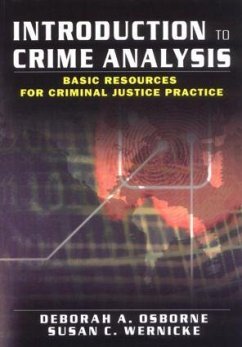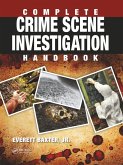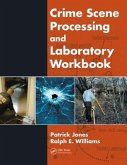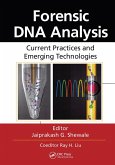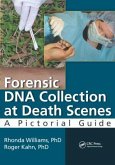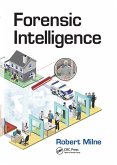Deborah Osborne, Susan Wernicke
Introduction to Crime Analysis
Basic Resources for Criminal Justice Practice
Deborah Osborne, Susan Wernicke
Introduction to Crime Analysis
Basic Resources for Criminal Justice Practice
- Broschiertes Buch
- Merkliste
- Auf die Merkliste
- Bewerten Bewerten
- Teilen
- Produkt teilen
- Produkterinnerung
- Produkterinnerung
This book is a practical resource guide for the development of crime analysis in local law enforcement. The tragedy of September 11, 2001, has raised awareness on how crucial it is to analyze information and intelligence. Smaller agencies that cannot financially justify hiring a full-time analyst will find strategies and techniques to teach officers the methods of analysis. Introduction to Crime Analysis: Basic Resources for Criminal Justice Practice provides basic tools and step-by-step directions that will improve the skills and knowledge of new crime analysts.
Andere Kunden interessierten sich auch für
![Complete Crime Scene Investigation Handbook Complete Crime Scene Investigation Handbook]() Everett Baxter JrComplete Crime Scene Investigation Handbook110,99 €
Everett Baxter JrComplete Crime Scene Investigation Handbook110,99 €![Crime Scene Processing and Laboratory Workbook Crime Scene Processing and Laboratory Workbook]() Patrick JonesCrime Scene Processing and Laboratory Workbook66,99 €
Patrick JonesCrime Scene Processing and Laboratory Workbook66,99 €![Forensic DNA Analysis Forensic DNA Analysis]() Forensic DNA Analysis116,99 €
Forensic DNA Analysis116,99 €![Forensic DNA Collection at Death Scenes Forensic DNA Collection at Death Scenes]() Rhonda Williams F-AbcForensic DNA Collection at Death Scenes115,99 €
Rhonda Williams F-AbcForensic DNA Collection at Death Scenes115,99 €![Forensic Evidence Management Forensic Evidence Management]() Forensic Evidence Management93,99 €
Forensic Evidence Management93,99 €![Forensic Intelligence Forensic Intelligence]() Robert MilneForensic Intelligence78,99 €
Robert MilneForensic Intelligence78,99 €![Case Studies in Drowning Forensics Case Studies in Drowning Forensics]() Kevin GannonCase Studies in Drowning Forensics101,99 €
Kevin GannonCase Studies in Drowning Forensics101,99 €-
-
-
This book is a practical resource guide for the development of crime analysis in local law enforcement. The tragedy of September 11, 2001, has raised awareness on how crucial it is to analyze information and intelligence. Smaller agencies that cannot financially justify hiring a full-time analyst will find strategies and techniques to teach officers the methods of analysis. Introduction to Crime Analysis: Basic Resources for Criminal Justice Practice provides basic tools and step-by-step directions that will improve the skills and knowledge of new crime analysts.
Hinweis: Dieser Artikel kann nur an eine deutsche Lieferadresse ausgeliefert werden.
Hinweis: Dieser Artikel kann nur an eine deutsche Lieferadresse ausgeliefert werden.
Produktdetails
- Produktdetails
- Verlag: Taylor & Francis
- Seitenzahl: 172
- Erscheinungstermin: 2. September 2003
- Englisch
- Abmessung: 212mm x 154mm x 12mm
- Gewicht: 272g
- ISBN-13: 9780789018687
- ISBN-10: 0789018683
- Artikelnr.: 21081760
- Herstellerkennzeichnung
- Libri GmbH
- Europaallee 1
- 36244 Bad Hersfeld
- gpsr@libri.de
- Verlag: Taylor & Francis
- Seitenzahl: 172
- Erscheinungstermin: 2. September 2003
- Englisch
- Abmessung: 212mm x 154mm x 12mm
- Gewicht: 272g
- ISBN-13: 9780789018687
- ISBN-10: 0789018683
- Artikelnr.: 21081760
- Herstellerkennzeichnung
- Libri GmbH
- Europaallee 1
- 36244 Bad Hersfeld
- gpsr@libri.de
Deborah Osborne is a crime analyst for the Buffalo Police Department and co-founder/vice president of the Western New York Regional Association of Crime and Intelligence Analysts. She serves on the by-laws committee and the certification committee of the International Association of Crime Analysts (IACA). She is a state certified police instructor and has served as an independent consultant to the Police Service of Northern Ireland (formerly RUC). Ms. Osborne holds a BA in Psychology and an MA in Social Policy., Susan Wernicke has set up a crime analysis unit for the Shawnee Police Department after working ten years for the Overland Park, Kansas, Police Department. During her tenure at the Overland Park Police Department, she held the positions of communications officer, police report clerk, and crime analyst. She has contributed to various publications on crime mapping, including Crime Mapping Successes in the Field, Volumes I and II, and Crime Mapping: Principal and Practice. She has also authored various articles on crime analysis, including an article for The Police Chief magazine titled Integrating Crime Analysis into Local Law Enforcement. Ms. Wernicke is the former Training Coordinator for the Mid-America Regional Crime Analysis Network (MARCAN) and is a crime analysis instructor for the International Association of Chiefs of Police (IACP). She is also the Secretary on the Executive Board for the International Association of Crime Analysts (IACA). She serves as the Committee Chair for the Publications Committee and for the Training Series Oversight and Implementation Committee. In December 2001, Ms. Wernicke was the keynote speaker
Preface
Acknowledgments
Chapter 1. What Is Crime Analysis?
The Challenge of Defining Crime Analysis
The Present State of Crime Analysis in Law Enforcement
Why Analyze Crime?
Types of Crime Analysis
Summary
Suggested Reading
Chapter 2. The Crime Analyst's Toolbox
Overview
Equipment
Knowledge of the Law
Knowledge of Investigative Processes
Knowledge of Modern Policing Strategies
Linkage Analysis
Statistical Analysis
Profiling
Spatial Analysis
Summary
Suggested Reading
Chapter 3. Moving Through the Stages of Crime Analysis
Collection
Collation
Analysis
Dissemination
Feedback and Evaluation
The Intelligence Cycle: Another View of the Stages of Analysis
Summary
Chapter 4. Geographic Information Systems: Issues and Resources
Overview
Points to Remember When Creating Crime Maps
Mapping Other Data with Crime Data for Analysis
Privacy Issues
Resources for Crime Mapping
Suggested Readings
Chapter 5. Crime Analysis Products
Creating Bulletins for Tactical Crime Analysis
Types of Administrative Crime Analysis Reports
Other Crime Analysis Products
Intelligence Analysis Products
Evaluation of Crime Analysis Products
Resources for Crime Analysis Products
Chapter 6. Advice for the New Crime Analyst
A Day in the Life of a Crime Analyst
Tips for the New Crime Analyst
The Ten Commandments of Crime Analysis
Chapter 7. Creating a Crime Analysis Unit
Policy and Procedures for Crime Analysis
Considerations in Creating a Crime Analysis Unit
Crime Analysis Units on the Web
Marketing and Funding Crime Analysis
How Do We Measure Success?
Crime Analysis Success Stories
Chapter 8. Education and Training Resources
Overview
Training Options for Those Employed in Law Enforcement
Eduction and Training Offered by Colleges and Universities
Chapter 9. Other Resources
Recommended Agency Resources
Recommended Publications
Recommended Internet Sites
Appendix. Examples of Crime Analysis Products
Bibliography
Index
Reference Notes Included
Acknowledgments
Chapter 1. What Is Crime Analysis?
The Challenge of Defining Crime Analysis
The Present State of Crime Analysis in Law Enforcement
Why Analyze Crime?
Types of Crime Analysis
Summary
Suggested Reading
Chapter 2. The Crime Analyst's Toolbox
Overview
Equipment
Knowledge of the Law
Knowledge of Investigative Processes
Knowledge of Modern Policing Strategies
Linkage Analysis
Statistical Analysis
Profiling
Spatial Analysis
Summary
Suggested Reading
Chapter 3. Moving Through the Stages of Crime Analysis
Collection
Collation
Analysis
Dissemination
Feedback and Evaluation
The Intelligence Cycle: Another View of the Stages of Analysis
Summary
Chapter 4. Geographic Information Systems: Issues and Resources
Overview
Points to Remember When Creating Crime Maps
Mapping Other Data with Crime Data for Analysis
Privacy Issues
Resources for Crime Mapping
Suggested Readings
Chapter 5. Crime Analysis Products
Creating Bulletins for Tactical Crime Analysis
Types of Administrative Crime Analysis Reports
Other Crime Analysis Products
Intelligence Analysis Products
Evaluation of Crime Analysis Products
Resources for Crime Analysis Products
Chapter 6. Advice for the New Crime Analyst
A Day in the Life of a Crime Analyst
Tips for the New Crime Analyst
The Ten Commandments of Crime Analysis
Chapter 7. Creating a Crime Analysis Unit
Policy and Procedures for Crime Analysis
Considerations in Creating a Crime Analysis Unit
Crime Analysis Units on the Web
Marketing and Funding Crime Analysis
How Do We Measure Success?
Crime Analysis Success Stories
Chapter 8. Education and Training Resources
Overview
Training Options for Those Employed in Law Enforcement
Eduction and Training Offered by Colleges and Universities
Chapter 9. Other Resources
Recommended Agency Resources
Recommended Publications
Recommended Internet Sites
Appendix. Examples of Crime Analysis Products
Bibliography
Index
Reference Notes Included
Preface
Acknowledgments
Chapter 1. What Is Crime Analysis?
The Challenge of Defining Crime Analysis
The Present State of Crime Analysis in Law Enforcement
Why Analyze Crime?
Types of Crime Analysis
Summary
Suggested Reading
Chapter 2. The Crime Analyst's Toolbox
Overview
Equipment
Knowledge of the Law
Knowledge of Investigative Processes
Knowledge of Modern Policing Strategies
Linkage Analysis
Statistical Analysis
Profiling
Spatial Analysis
Summary
Suggested Reading
Chapter 3. Moving Through the Stages of Crime Analysis
Collection
Collation
Analysis
Dissemination
Feedback and Evaluation
The Intelligence Cycle: Another View of the Stages of Analysis
Summary
Chapter 4. Geographic Information Systems: Issues and Resources
Overview
Points to Remember When Creating Crime Maps
Mapping Other Data with Crime Data for Analysis
Privacy Issues
Resources for Crime Mapping
Suggested Readings
Chapter 5. Crime Analysis Products
Creating Bulletins for Tactical Crime Analysis
Types of Administrative Crime Analysis Reports
Other Crime Analysis Products
Intelligence Analysis Products
Evaluation of Crime Analysis Products
Resources for Crime Analysis Products
Chapter 6. Advice for the New Crime Analyst
A Day in the Life of a Crime Analyst
Tips for the New Crime Analyst
The Ten Commandments of Crime Analysis
Chapter 7. Creating a Crime Analysis Unit
Policy and Procedures for Crime Analysis
Considerations in Creating a Crime Analysis Unit
Crime Analysis Units on the Web
Marketing and Funding Crime Analysis
How Do We Measure Success?
Crime Analysis Success Stories
Chapter 8. Education and Training Resources
Overview
Training Options for Those Employed in Law Enforcement
Eduction and Training Offered by Colleges and Universities
Chapter 9. Other Resources
Recommended Agency Resources
Recommended Publications
Recommended Internet Sites
Appendix. Examples of Crime Analysis Products
Bibliography
Index
Reference Notes Included
Acknowledgments
Chapter 1. What Is Crime Analysis?
The Challenge of Defining Crime Analysis
The Present State of Crime Analysis in Law Enforcement
Why Analyze Crime?
Types of Crime Analysis
Summary
Suggested Reading
Chapter 2. The Crime Analyst's Toolbox
Overview
Equipment
Knowledge of the Law
Knowledge of Investigative Processes
Knowledge of Modern Policing Strategies
Linkage Analysis
Statistical Analysis
Profiling
Spatial Analysis
Summary
Suggested Reading
Chapter 3. Moving Through the Stages of Crime Analysis
Collection
Collation
Analysis
Dissemination
Feedback and Evaluation
The Intelligence Cycle: Another View of the Stages of Analysis
Summary
Chapter 4. Geographic Information Systems: Issues and Resources
Overview
Points to Remember When Creating Crime Maps
Mapping Other Data with Crime Data for Analysis
Privacy Issues
Resources for Crime Mapping
Suggested Readings
Chapter 5. Crime Analysis Products
Creating Bulletins for Tactical Crime Analysis
Types of Administrative Crime Analysis Reports
Other Crime Analysis Products
Intelligence Analysis Products
Evaluation of Crime Analysis Products
Resources for Crime Analysis Products
Chapter 6. Advice for the New Crime Analyst
A Day in the Life of a Crime Analyst
Tips for the New Crime Analyst
The Ten Commandments of Crime Analysis
Chapter 7. Creating a Crime Analysis Unit
Policy and Procedures for Crime Analysis
Considerations in Creating a Crime Analysis Unit
Crime Analysis Units on the Web
Marketing and Funding Crime Analysis
How Do We Measure Success?
Crime Analysis Success Stories
Chapter 8. Education and Training Resources
Overview
Training Options for Those Employed in Law Enforcement
Eduction and Training Offered by Colleges and Universities
Chapter 9. Other Resources
Recommended Agency Resources
Recommended Publications
Recommended Internet Sites
Appendix. Examples of Crime Analysis Products
Bibliography
Index
Reference Notes Included

